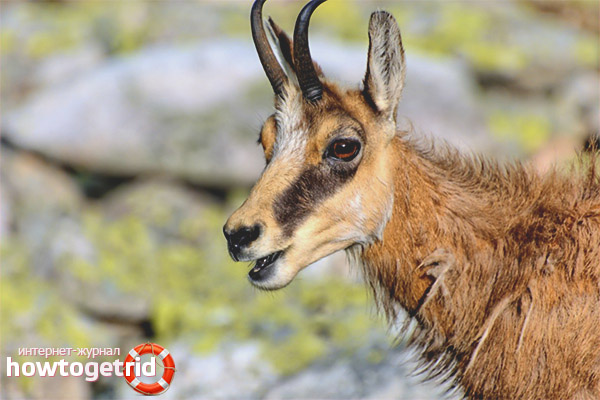The content of the article
In the mountains of Europe and Asia Minor live small elegant goats named chamois. From the Pre-Slavic language, the name can be translated as “horned”. And if translated from Latin, you get a "rock goat." In total there are 7 subspecies according to habitats. But the differences between them are very small.
Description
Chamois from the class of mammals, the composition is compact, it looks slim, thin neck, short muzzle, the length of the animal is about 1 meter, the height at the withers reaches 75 centimeters. The mass of the animal varies from 30 to 50 kilograms. The tail is very short, within 7-8 centimeters. The legs are also slender with flat hooves, with the forelimbs shorter than the hind legs. The length of the protruding ears is only half the length of the head itself. On the head of chamois of both sexes flaunt 25 centimeter horns, bent back. Behind them is a small hole from which a slimy smelly secret is released during the rut.
The color of the chamois changes in accordance with the season: in summer, the outer part has a red-brown color, and the belly is red with yellowness. The back of the paws is white, the lower limbs are black, the end of the tail becomes the same black color. From the ears to the eyes there is a black strip.
In winter, the back acquires a dark brown color, the belly whitens. Legs with head turn yellow-white.
Habitat
Favorite places to live are cliffs and mountain ranges covered with forests. They can live in any forest - birch, fir, mixed, but prefer coniferous. In the summer they climb into the high rocky areas, where they masterfully jump on stones and crevices. In winter, the cold is forced to descend into lowland forest thickets.
Behavior
Chamois usually live in small groups of 10-25 individuals. But sometimes these communities come together to form large herds. When such a herd is formed, an experienced female usually heads up. Mostly females live there, the strong sex avoids such a large crowd of people, living a solitary life, or forming groups consisting entirely of males. In a herd, they come only for procreation during the rut.
As already noted, in the warm season, animals climb high into the mountains, where one of the members of the group vigilantly guards, notifying the others of the onset of danger by whistling. As soon as the snow falls and hides food underneath, the animals descend down into the meadows. They have their favorite places to which they keep affection, feed there constantly, and even shepherds and hunters do not scare them.
The goats have a nocturnal lifestyle; they prefer to relax during the day. The chamois combine great curiosity with no less great cowardice. Another distinguishing feature of the chamois is the ability to jump quickly and far - at times the jump can reach 7 meters.
Breeding
Chamois become sexually mature at the age of 20-22 months, but begin to multiply only when they reach the age of three years.
The race lasts from the end of October, animals mate in November. The female walks pregnant for about 150 days, in May-June it is time to give birth, and the goats hide in the forest thickets. Usually one cub is born, less often twins, from the very first hours of life they show independence, almost immediately (after an hour or two) they can move after their mother.For some time, the parents, until the children are stronger, live with the offspring in the thicket, avoiding appearing in open spaces, but after a while they return back to the herd.
Mother feeds the children for three months, the first six months is always next to them. In the case of the death of the mother, other members of the herd take care of the little kids. At four months old, baby horns begin to appear, and by the end of the second year of life, their formation is completed.
Food
Chamois and the Red Book
All subspecies, except the Caucasian one, are listed in the Red Book, as the population decreases, and in Russia there are no more than two thousand chamois. And even then, most of them live only in nature reserves specially created by man.
Video: chamois (Rupicapra rupicapra)











Submit